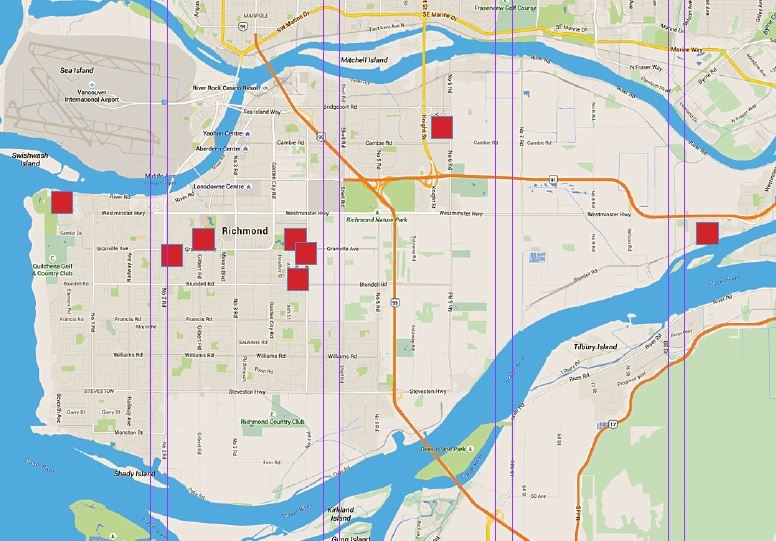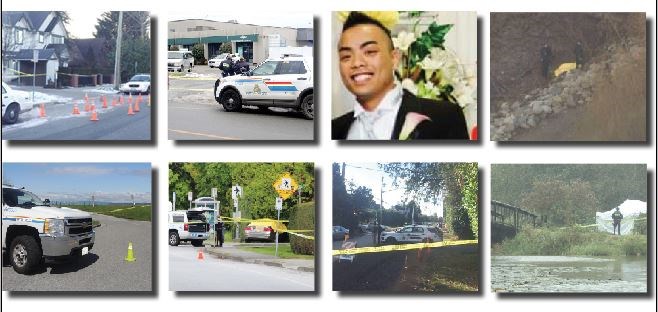An unwelcome spotlight — in light of a spiralling homicide rate — has been shining on Richmond in recent weeks.
A cold statistic making uncomfortable reading for local police and politicians shows homicides in the city already double that of recent years, and it’s still only October.
In the last five years, the suspicious death toll reads:
Zero in 2013;
Four in 2014;
Four in 2015;
Two in 2016;
Eight in 2017 (as of Oct. 10).

It’s a worrying leap that has many in power scratching their heads for answers, with this year’s deaths apparently scattered randomly across Richmond, save for three within a block of each other near Garden City Park.
According to IHIT (Integrated Homicide Investigation Team), only one of the deaths — business owner Martin Shen on Jan. 16 — has resulted in a suspect being charged.
The other seven cases, said IHIT, are ongoing and “active” investigations and none, say police, appear to be linked.
Of the eight homicide victims this year: only three of them were from Richmond; five were “known to police;” five died of gunshot wounds; and six were “targeted” — the latter indicating connections to organized crime.
The fact that the majority of the victims were from outside of Richmond — including, Surrey, Delta and Vancouver — was not lost on Richmond RCMP’s Supt. Will Ng.
“The 2017 year homicide rate is unacceptable and, as Officer in Charge of Richmond Detachment, I am very concerned,” Ng told the Richmond News in a statement.
“Our homicide numbers are generally quite low and I will reiterate that Richmond is a very safe community.
“Though I am unable to speak about the specifics of active homicide investigations, a common thread has presented, where the majority of homicide victims are known to police, but are not Richmond residents.”
Ng added that the RCMP are focusing on suppressing drug and gang activity and, while working with other law enforcement partners, will “find solutions to these violent acts and hold those responsible accountable...”
Coun. Bill McNulty, chair of Richmond city council’s community safety committee, also said he was “very, very concerned.”
“It’s still to be worked out where (the victims were killed). But it shows that we should be thinking about raising the complement of police officers to keep the community safe.
“We have spoken to the RCMP, and I’m told police patrols have been increased.”
McNulty said discussions have taken place with the RCMP about why 33 intersections in Richmond have had traffic cameras installed, but none of them, he said, are working.
“They are city cameras. The (police) superintendent has highlighted this as a problem,” added McNulty, in the context of the cameras providing extra security.
Asked if there is a particular organized crime problem in Richmond, McNulty said he didn’t think so.
“This is an inter-municipal problem. I’m not saying we don’t have a gang problem, per se. It would be naive to think we don’t have gang-related activity here.”
Gang activity knows no boundary: Police
The News asked both IHIT and B.C.’s Combined Forces Special Enforcement Unit (CFSEU), which specializes in tackling organized crime and gang activity, if the homicide spike in Richmond is a local problem or a spillover from other jurisdictions.
IHIT didn’t respond to the question, while CFSEU’s B.C. spokesperson, Sgt. Brenda Winpenny, said in an email that “although we have seen an increase in homicides as of late, it takes years to properly analyze information and make any determinations associated to trends of activity and truly understand the motivations behind it.
“As we have said in the past, gang activity and violence knows no boundary.
“A particular person may live in one jurisdiction and do his business in another. This is not any particular community’s issue, rather it is a bigger (B.C.) issue.
“We caution the public and media to draw conclusions as to what city may be the ‘root cause’ or seeing a spike, as it truly isn’t representative of the situation.”
Victims may be lured here: Professor
Rob Gordon, professor of criminology at Simon Fraser University, meanwhile, thinks that — given the limited information known about the homicides — the majority of the victims were likely lured to Richmond in some way, shape or form.
“These people are drawn to Richmond; it’s a lot more active and cosmopolitan than before,” said Gordon, in his hypothesis.
“And I would bet the casinos are involved in that reason for coming to Richmond, as well. It’s likely the people in question are being followed to determine their patterns of behaviour.
“(The killers) will pick a quiet moment to do their business and get out of there quickly.”
Gordon said there is also an “obvious connection” to the illegal drug trade in the region.
“The marijuana trade is changing drastically, mostly because of what is happening (with regulation) in Washington State.
“What used to be a market for B.C. bud is no longer there and that has created a lot of problems here with internal conflicts playing out.”
Asked if Richmond was seen by gangsters in the organized crime trade as neutral territory for “meetings” to take place and, thus, targeted hits carried out, Gordon said “terrain is terrain.”
“The notion of ‘ground’ and ‘patches’ is long gone, and it never really was the case in the Lower Mainland anyway,” he said.
“And to call some group a gang is not helpful; it’s more a group of individuals who get together, without names, with the primary objective to make money and maintain a low profile.
“But the temperature has gone up among these groups recently because their market share is evaporating.
“The problems start if someone doesn’t play fair within their ‘moral structure’ or there is a ‘breach of contract.’”



